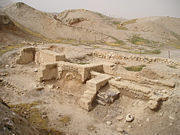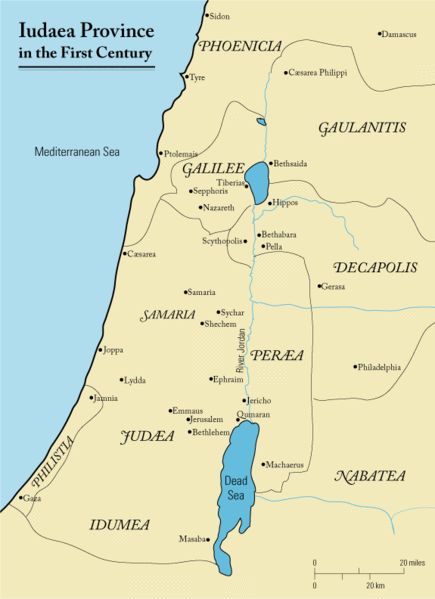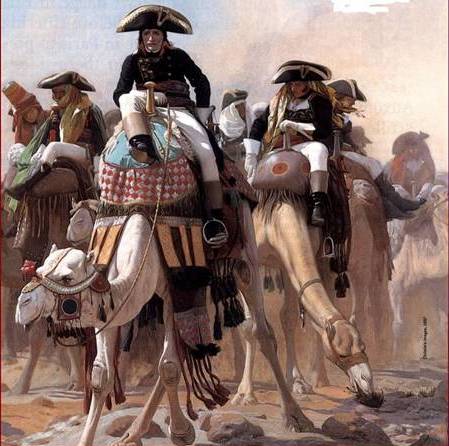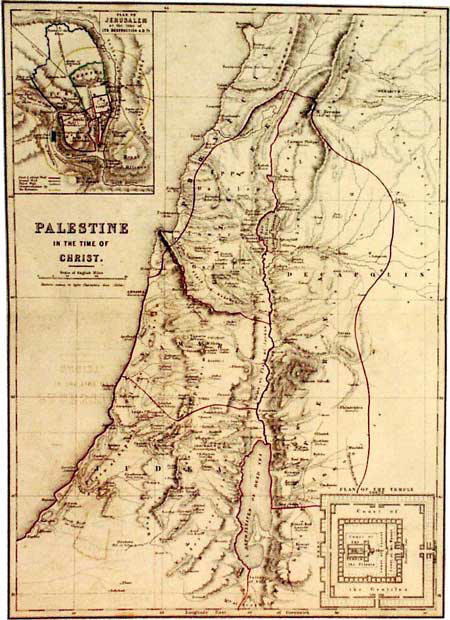To your descendants I give this land, from the
river of Egypt to the great river, the Euphrates.
Genesis
A Brief History of
Israel
he
Bible recounts the history of the ancient Hebrew civilization, which in
reality has very, very, little in common with modern Israel. The story
commences in Genesis: God made a covenant with Abraham and said, ‘To
your descendants I give this land, from the river of Egypt to the great
river, the Euphrates’, and came to end under the Romans.
The end of
the ancient Hebrew civilization in fact occurred in two steps: the first when
their Temple was razed by Titus in 70AD and second when Hadrian crushed
the Second Jewish Revolt in 130AD, rebuilding Jerusalem as a Roman city
and naming it Aelia Capitolina. The Jews were dispersed to the four
corners of the Roman world, their homeland destroyed and transformed
into a Roman province, their Temple razed to the ground, not a stone
remained, its site never again found, erased from human memory. The
Israel of today is made up of a people forged from Germans, North
Africans, Russians, Ethiopians, Yemenis, Iraqis, Iranians, Ukrainians,
Arabs and many others, living together in a reconstituted
land, which was colonised and then progressively appropriated by the new
arrivals.

Logically
the questions that we dare not ask should be asked, not with the
objective of hurting or dividing, but trying to explain the perhaps unexplainable.
Leaving aside the ethical and politically correct considerations defined
by Western civilization in the third millennium for a moment, it can be
asked what the
peoples of the countries mentioned above have culturally speaking little in
common? Are European Jews members of the same ethnic family that
speak Hameo-Semetic languages? Are Ethiopian Jews culturally the same as
Siberian Jews? This is not a question of trying to define belongings or
trying to balance the politically dangerous question of what is a
people, but simply to objectively look at the constitution of the
population of modern Israel relative to that of the time of Herod, which
may or may not have been homogeneous. The same question could be asked
relative to the Hebrews at the time of Solomon or even Moses or Abraham.
The answer is of course religion. It is not language; the people
of Israel spoke Hebrew, Greek, Aramaic, Latin and other languages.
Religion bounds and binds these different elements together. Will the Israelis of tomorrow resemble those of today? It is impossible
to say. In comparison the Britons of the time of Boadecia would have had little in
common with the Normans or the English of William Shakespeare’s time,
and even less with Victorians or the multi-ethnic British society of the
21st century, but they were all Britons or became Britons.
What is
left of the past, what became of the ancient Jews, what became of their
religion, language and culture, what had become of their temples, cities
and monuments?
The
archaeological history of what is modern Israel and Palestine, in terms
of the earliest agricultural communities, commences sometime between
10000 and 5000BC. The Bible story commences with a people descended from Abraham called the Hebrews who
founded the Kingdoms of Israel. The Hebrew name Yehudi came into
being after the Kingdom of Israel was split into the northern Kingdom of
Israel and the southern Kingdom of Judah. The Latin word Iudeus is
derived from the Greek Ioudaios, and means Judaean, from the land of
Judaea. Later following the destruction of Jerusalem by the Romans, the
word Jew came to mean a follower of the Jewish faith, or someone of
Jewish descent.
 Between 10000 and 5000 BCE, agricultural communities
were established. Evidence of such settlements were found at Tell es-Sultan
(picture to the left), Jericho and include mud-brick rounded and square
dwellings, pottery shards, and fragments of woven fabrics.
Between 10000 and 5000 BCE, agricultural communities
were established. Evidence of such settlements were found at Tell es-Sultan
(picture to the left), Jericho and include mud-brick rounded and square
dwellings, pottery shards, and fragments of woven fabrics.
But
commencing with the solid vestiges of their past we are forced to admit very little remains,
there are of course the Hasmonian tombs, there is absolutely nothing
that resembles the ruins of Egypt, Rome or Ancient Greece, neither
Babylon nor Persia, or Hattusa the capital of the Hittites, or even the
Nabeatean city of Petra. The Jews ancient language, which became practically
extinct as a spoken language in around the third century AD, was revived
and modernised, it had been barely spoken outside of synagogues,
replaced by the languages and dialects of their respective homelands, Ladino,
Yiddish, Russian and many others. Their culture was that of their
different
countries. So what was Judaism, what bound the Jews together, were they
bound together? Was it a religion based on the Bible, the Torah and
other ancient texts, the collective memory of an ancient people with its
commentaries, or was it the collective rejection and persecution of
their descendants by the Christians and Muslims in the lands they had
made their homes.
Did they
consider Andalusia, Spain, France, Germany, Russia, North Africa or the
Middle East as their homelands? What did an Austrian Jew living in
Vienna in 1900 have in common with a Moroccan Jew living Marrakech? It
was certainly not their language, or their culture. To find a common
root it was necessary to go back perhaps two thousand years, a link as
tenuous as that of an Italian Christian with an early Roman Christian in
Palestine.
When did
the Hebrews become Jews? To trace their history it is necessary to go
back to the biblical legend of King David and his son Solomon, who built
the first Temple of the Hebrews in Jerusalem, which according to the
Bible stood for 400 years, until in 588BC King Nebuchadnezzar of Babylon
conquered the city and destroyed the Temple, exiling the Hebrew leaders
and their elite to Babylon.
Then came
the Persians who defeated the Babylonians in 540BC and Cyrus the Great,
King of the Persians, allowed the Hebrew exiles to return home from
Babylon. The Second Temple was was built under Nehemiah, who was
appointed governor by the Persians in 445 BC, when the walls of the
Temple Mount were rebuilt and its fortifications strengthened.
Over the
course of the following 500 years, the Greeks, Seleucids and Romans took
turns in conquering the city, at times forbidding Jewish religious
practices in an effort to assimilate the Jews into their respective
cultures.
Alexander
the Great conquered Jerusalem in 333 BCE and then established Hellenistic
monarchies in the Eastern Mediterranian: the Ptolemies in Egypt, the
Seleucid dynasty in Syria under Seleucus I Nicator. Under Antiochus III
they captured Jerusalem from the Egyptians and Palestine fell under
Syrian rule. The desecration of the Temple by Antiochus IV provoked a
Jewish insurrection led by Judah Maccabee, who succeeded in defeating
the Syrians in 161BC, liberating Jerusalem and re-establishing Jewish
worship in the Temple.
After one
hundred years of independence civil war broke out and the Romans, under
Pompey, conquered Judea in 63BC, ending the autonomy of Israel for two
thousand years. The Jews simply became another of the many different
peoples of the Roman Empire.
The Romans
ruled over Palestine relatively peacefully for nearly a century until
the First Jewish Revolt 66AD. It had been ruled as a vassal state like
the other provinces of the eastern part of the Roman Empire. Herod, a
Judean, who was made king in 37BC and ruled until 4BC, was a friend of
Agrippa, the son-in-law of the Emperor Augustus, and built many cities
including Caesarea, where the Roman governor resided, and more
significantly
he transformed the Temple of Jerusalem into a magnificent edifice to be
worthy of the Jewish God Yaweh.
After
Herod's death, Judea was divided among his three sons, but their endless
quarrels resulted in Rome appointing a governor to rule Palestine and
Jerusalem directly from his official residence in Caesarea. One of these
was Pontius Pilate, who governed from 26-36AD.
An
unsettled period followed with periodic riots in Jerusalem resulting in
frequent clashes with Roman troops. In 66AD, when the population of
Jerusalem had reached an estimated 150,000-200,000 inhabitants, a much
more serious revolt broke out against Roman rule; it ended in 70AD when
a Roman army of 80,000 soldiers, under the leadership of Titus, besieged
and conquered the city, plundering then razing the Temple to the ground.
More than 100,000 Jews were killed or died of hunger, the rest were
executed or sold in slavery. Virtually the entire city was destroyed and
all Jews banished from Jerusalem.
In 130AD,
the Emperor Hadrian after crushing the Second Jewish Revolt decided to
rebuild Jerusalem as a Roman city and the city was renamed Aelia
Capitolina. When Christianity became the state religion of the Roman
Empire in the 4th century, Queen Helena and her son, the Byzantine
Emperor Constantine, transformed Jerusalem into a Christian city.
Almost all
of the population of Palestine had by then been converted to
Christianity, with however, the exception of some Jews. The Byzantines
forbid the remaining Jews entry into Jerusalem, except for just one day a
year, when they mourned the destruction of their Temple, who were also
deprived of most of their rights including the building of synagogues.
During
these Christian centuries Persia continued to be a threat to Christian
Palestine and the capture of Antioch by the Persian Emperor Khosrau I in
540AD was the beginning of the last great Persian onslaught against
Byzantium. In the early 7th century Khosrau II launched his attack,
giving hope to the Jews that the Christians would be defeated and their
rights be restored just as they had been after the Persians captured
Jerusalem in 540BC.
In the
spring of 614 the Persian army entered Palestine burning Christian
churches and reached soon Jerusalem. When the city fell 60,000
Christians are massacred and another 35,000 were sold into slavery, and
symbolically worse taking the most holy relic of Christendom, the True
Cross of Christ back to Persia as part of their booty.
In AD 622
the Byzantine Emperor Heraclius counter attacked sweeping through Asia
Minor and Armenia to the frontier of Persia. After a series of attacks
and counter-attacks the war ended when Heraclius entered Mesopotamia and
defeated the Persians at Nineveh destroying Khosrau's palace in the
Persian capital of Ctesiphon. The True Cross was returned in 629AD, to
the Holy Sepulchre in Jerusalem.
But, peace
did not last long as a new threat suddenly appeared from nowhere with a new
religion and the emergence of the Arabs with a powerful all conquering
army composed of desert tribesmen from Arabia. The Christian cities of Syria
and Palestine quickly fell to the Arabs. In 635AD, Damascus, and in
638AD Jerusalem fell to the Muslim army of Caliph Omar after a siege
that lasted for a year.
Mohammed
had preached that Moses and Jesus were prophets, his predecessors, and Jerusalem took on a special significance.
In 691AD,
the Caliph Abd al- Malik of the Umayyad dynasty built the Dome of the Rock
on the supposed site of the Jewish Temple. Jerusalem thus became the third
most holy place for the Muslims after Mecca and Medina.
Under
Muslim rule, a Jewish community was re-established in Jerusalem and
flourished. Jews were even among those who guarded the walls of the Dome
of the Rock. In return, they were absolved from paying the poll-tax
imposed on all non-Muslims.
The Muslim
dynasty of the Umayyads ruled most of the Arab world in the second half of
the 7th Century, but after a dispute with the rulers of Mecca and Medina,
the holiest of Islamic cities, they decided to make Jerusalem, which was
nearer their capital Damascus, a holy city to counter the rivals of
Mecca and Medina. They
rebuilt Al-Aqsa and also built a magnificent monument, the Dome of the
Rock, on the summit of the mountain, on the presumed site of the Jewish
temple. They also built palaces to the south of the mountain and their
actions made Jerusalem the third holiest city of Islam.
Then the
Abbasid dynasty moved the Arab capital from Damascus to Baghdad with the
result that Jerusalem declined in importance, enabling the
Crusaders to take the Holy City in 1099 AD, massacring tens of
thousands of its Muslim and Jewish inhabitants. King Baldwin I became
the first ruler of the Crusaders' Kingdom, called the Kingdom of
Jerusalem, until 1187AD when Sultan Salah a-Din besieged and captured
the city. The Jews were allowed to return in 1210AD joined by other Jews
from Europe and the Maghreb.
Jerusalem
lost its importance as a political centre under the Muslim rulers first
belonging to the province of Damascus, then becoming a separate
province. It fell to the Turks in 1517AD, and remained under their
control for four centuries.
At the
beginning of the 19th century the population of Jerusalem was just 9,000
inhabitants. It was about that time the city and the Near East were
rediscovered by the competing European nations, commencing with
Napoleon’s expedition to Egypt.
‘We must go
to the Orient. All great glory resides there.’ In addition to the thirty odd
thousand troops that landed near Alexandria there were almost one
thousand officials, artists and poets, botanists and zoologists,
surveyors and economists, who compiled the Descriptions de l'Egypte, the
twenty-two volumes of which were to be one of the most famous
descriptions of Egyptology to that time. The treasure he brought back to
France included the Rosetta Stone which was to provide the key to
Egyptian hieroglyphics deciphered by Champolian.

In
Napoleon's plans to conquer Egypt, part of the Ottoman Empire, he attacked the Turks
by marching on Palestine with an army of 13,000 men in the spring of
1799, sacking Jaffa after bombarding it with his artillery.
Jerusalem was of no military importance, though Napoleon wrote to the
Jews backing the idea of a Jewish nation. At that time less than two
thousand Jews lived in the City of Jerusalem, a miserable backwater. He
target was Acre, which he believed to be a strategic point in the Holy
Land, but he failed to capture the city when his troops were ravaged by
plague.
A century
later, the city's population had reached 55,000 of which more than half
were Jews.
In the
course of the
First World War came the Balfour Declaration of 2 November 1917, in
which Great Britain declared: ‘His Majesty's Government view with favour the
establishment in Palestine of a national home for the Jewish people, and
will use their best endeavours to facilitate the achievement of this
object, it being clearly understood that nothing shall be done which may
prejudice the civil and religious rights of non-Jewish communities in
Palestine or the rights and political status enjoyed by Jews in any
other country.’
Following
the victory of the Allies over Germany and its Turkish ally the Ottoman
Empire was dismantled and Britain occupied Palestine, which at that time
included the territory that is now Jordan.
The Mandate
zone covered more than one hundred thousand square kilometres, but 1921,
Britain split it into two zones, three quarters to the east of the
Jordan River was made into an Arab protectorate, which was to become the
Kingdom of Jordan, from where the Jews were forbidden to live or own
land. The territory to the west of the river became what we as Israel
and the Occupied Territories today.
Modern
Israel commenced after the First World War when Britain was given the
Mandate for Palestine by the League of Nations. This included the
creation a Jewish National Home in the territory, according to the
Balfour Declaration.
In the
following years the hostility of the Arab population to Jewish
immigration and the majority Jewish presence in Jerusalem grew.
Outbreaks of violence against Jewish residents were frequent often
resulting in death and injury. This led to the British government
seriously restricting Jewish immigration to Palestine in 1939.
In 1947,
the United Nations General Assembly voted to partition Mandatory
Palestine into Jewish and Arab states with Jerusalem under a special
international regime. Immediately the State of Israel was proclaimed and
an Arabs coalition composed of Egypt, Iraq, Jordan and Syria attacked
Israel.
An
armistice was signed in 1949 between Israel and Jordan, and Jerusalem
was divided into two zones, the West became the capital of Israel whilst
the East was the Arab city until the 1967 war when Israel occupied the
whole city.
In the
nineteenth century Palestine was part of the tottering Ottoman Empire,
and was seen by the Arabs as part of Bilad ash-Sham, or Great Syria, a
region that approximately includes what is now Syria, Lebanon, Israel
and Jordan. In 1831 the region was usurped by Muhammad Ali of Egypt from
his Ottoman suzerains.
What role
did the Arabs play in the Ottoman Empire? The Sultan in Istanbul was the
Caliph, that is to say the successor of Mohammed, the supreme religious
authority of the Muslim world. The Arabs saw the Ottoman Empire just as
much as their Empire as the Turks, as Muslims they were proud of the
Empires power and prestige, fighting for it, at first to expand Ottoman
Europe and then to defend it.

Before the
1890s there had already been attempts to settle Jews in Palestine, which
at that time had a population of some 520,000 people, mostly Muslim and
Christian Arabs and about five percent Jews.
Jewish
immigration to the Holy Land had started in the 1870s with the arrival
of small numbers of Russian Jews fleeing the anti-Jewish pogroms when
the Jews were wrongly blamed for the assassination of the Tsar Alexander
II, though the Ottomans discouraged large-scale immigration to
Palestine. At that time most Jews in Palestine belonged to the old
Yishuv, or community, that had settled in the Holy Land for religious
reasons and peacefully cohabited with the Arabs. Tensions between the
Jews and Arabs commenced after the first Zionist settlers arrived in the
1880s, purchasing land the absentee Arab owners.
As a result Arab
anti-Zionism commenced in the late nineteenth century with the arrival
of significant numbers of Jewish settlers in Palestine.
Between 1882 and 1903, about 35,000 Jews
arrived in
Palestine, though however, many of them soon left as their lives
as small time farmers was extremely hard. In 1891, the first sign of
political opposition to Zionism made its appearance. Arab notables from
Jerusalem called upon the Ottoman administration to prohibit the
immigration of and the sale of land to Jews and the Ottoman rulers took
measures to restrict immigration and land purchase. But with the
Zionists, a political movement that advocated a homeland for the Jewish
People in the Land of Israel, the Ottomans gave way to European demands
and immigration grew. The poor Arab peasants naturally considered the
land on which they had lived for generations to be theirs, but it was
sold from under their feet without their knowledge by the absentee
landlords, the legal owners, to Jewish settlers. Those Palestine Arab
farmers who refused to move from the land purchased from absentee owners
were evicted by the Turkish authorities.
 Theodor
Herzl, an Austrian Jewish journalist, the founder of modern
political Zionism, wrote in his diary after the first Zionist Congress
in Basle, Switzerland, in August, 1897: ‘Were I to sum up the Basle
Congress in a word - which I shall guard against pronouncing publicly - it
would be this: “At Basle, I founded the Jewish State. If I said this out
loud today, I would be answered by universal laughter. If not in 5
years, certainly in 50, everyone will know it.”’
Theodor
Herzl, an Austrian Jewish journalist, the founder of modern
political Zionism, wrote in his diary after the first Zionist Congress
in Basle, Switzerland, in August, 1897: ‘Were I to sum up the Basle
Congress in a word - which I shall guard against pronouncing publicly - it
would be this: “At Basle, I founded the Jewish State. If I said this out
loud today, I would be answered by universal laughter. If not in 5
years, certainly in 50, everyone will know it.”’
Land was
sold to Jewish settlers by Palestinian Arabs attracted by the
possibility of quick profits thus causing prices to rise creating a
vicious circle whereby absentee landlords hastened to sell there land
before the music stopped. This was accelerated by the severe economic
depression that affected the territory resulting in unemployment and
economic difficulties which only went to aggravate the situation of many
Arab peasants, who were forced to sell their land to survive.
In 1931 the
Jewish population had risen to almost two hundred thousand and the
British High Commissioner for Palestine at that time recommended the
total suspension of Jewish immigration and land purchase to protect Arab
agriculture as all cultivatable land was was occupied by the indigenous
population and sale to Jews would create a class of landless Arab
cultivators.
The Arabs
proclaimed a general strike in 1936 boycotting Jewish businesses and
goods, they demanded an end to Jewish immigration and land transfers to
Jewish owners together with a new government that represented their
interests. In a campaign of terror Jews were killed as armed gangs of
Arabs attacked Jews until in August 1936 the British crack-down on the
terrorists.
At that
time David Ben Gurion, noted that ‘in our political argument abroad, we
minimize Arab opposition to us,’ whilst he recommended, ‘let us not
ignore the truth among ourselves.’ The revolt was brutally put down by
the British authorities.
Violence
continued on and off until 1939 when World War Two more or less
suspended suspended political unrest.
By 1949,
after the founding of the State of Israel, the
population of the country was approximately 1,200,000 people, of which were
86% were Jews. In 2006 it was nearing 7,000,000 with almost 80% Jews.
CONTINUE
READING
go back to previous
page


 Between 10000 and 5000 BCE, agricultural communities
were established. Evidence of such settlements were found at Tell es-Sultan
(picture to the left), Jericho and include mud-brick rounded and square
dwellings, pottery shards, and fragments of woven fabrics.
Between 10000 and 5000 BCE, agricultural communities
were established. Evidence of such settlements were found at Tell es-Sultan
(picture to the left), Jericho and include mud-brick rounded and square
dwellings, pottery shards, and fragments of woven fabrics.



 Theodor
Herzl, an Austrian Jewish journalist, the founder of modern
political Zionism, wrote in his diary after the first Zionist Congress
in Basle, Switzerland, in August, 1897: ‘Were I to sum up the Basle
Congress in a word - which I shall guard against pronouncing publicly - it
would be this: “At Basle, I founded the Jewish State. If I said this out
loud today, I would be answered by universal laughter. If not in 5
years, certainly in 50, everyone will know it.”’
Theodor
Herzl, an Austrian Jewish journalist, the founder of modern
political Zionism, wrote in his diary after the first Zionist Congress
in Basle, Switzerland, in August, 1897: ‘Were I to sum up the Basle
Congress in a word - which I shall guard against pronouncing publicly - it
would be this: “At Basle, I founded the Jewish State. If I said this out
loud today, I would be answered by universal laughter. If not in 5
years, certainly in 50, everyone will know it.”’